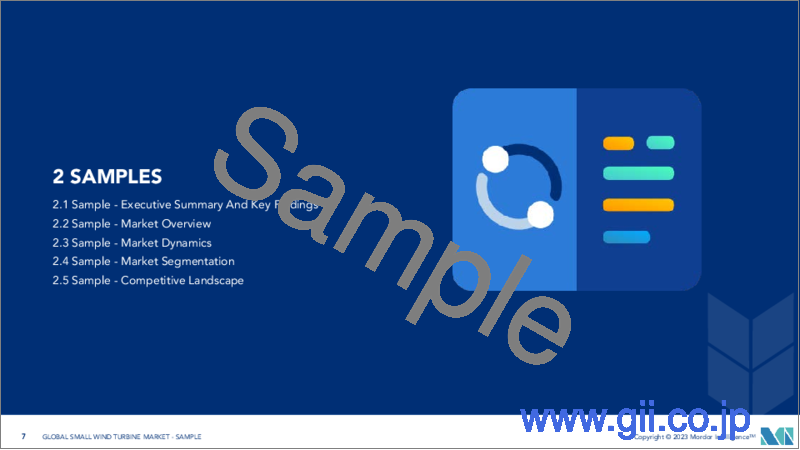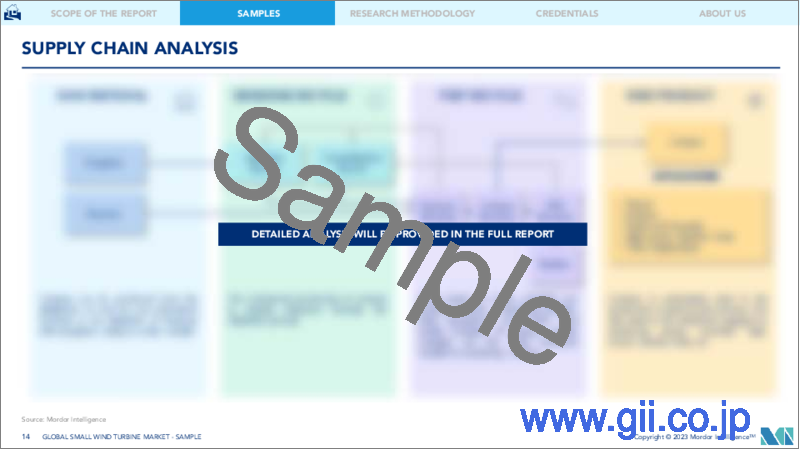|
|
市場調査レポート
商品コード
1198355
小型風力タービン市場- 成長、動向、予測(2023年~2028年)Small Wind Turbine Market - Growth, Trends, and Forecasts (2023 - 2028) |
||||||
|
● お客様のご希望に応じて、既存データの加工や未掲載情報(例:国別セグメント)の追加などの対応が可能です。 詳細はお問い合わせください。 |
|||||||
| 小型風力タービン市場- 成長、動向、予測(2023年~2028年) |
|
出版日: 2023年01月23日
発行: Mordor Intelligence
ページ情報: 英文 133 Pages
納期: 2~3営業日
|
- 全表示
- 概要
- 目次
小型風力タービン市場は、2020年に2億7740万米ドル、2027年には3億900万米ドルに達すると予測され、2022~2027年のCAGRは1.19%で成長しています。
COVID-19のパンデミックは、2020年の間、市場に大きな影響を与えなかっています。CAPEX要件の低下、環境への関心の高まり、オフグリッドアプリケーションからの需要などの要因が、市場を牽引すると予測されます。また、風力タービンの製造コスト削減や効率化につながる技術の進歩も、小型風力タービン市場の成長の主な要因となっています。しかし、屋上ソーラーや小規模バイオエネルギー施設など、小規模な再生可能開発のための代替エネルギー源の採用が増加していることが、予測期間中の市場成長の妨げになると見られています。
主なハイライト
- 2021年の市場は水平軸型風力タービンのセグメントが支配的であり、予測期間中も同じ傾向で成長すると予想されます。
- 高層ビル屋上への小型風力タービンの配備は、多くの欧米諸国において調査され、限られた容量で実施されています。これは、二酸化炭素排出量の多い都市部での再生可能エネルギー発電と消費を再定義することができるため、将来的に小型風力タービンのいくつかの機会を創出することができます。
- アジア太平洋地域は、中国やインドなどの国からの需要が大半を占めており、市場の成長を支配すると予想されます。
小型風力タービンの市場動向
水平軸型風力タービンセグメントが市場を独占すると予想
- 水平軸型風力タービン(HAWT)は、メインローター軸と発電機をタワーの最上部に配置し、単純な風向計によって卓越風の方向や風向きを変えることができます。
- 小型風力タービン市場において、水平軸型風力タービンは大きなシェアを占めています。小型垂直軸風力タービン(VAWT)の多くがここ10年間に生産されたのに対し、水平軸風力タービンは30年以上前から生産されています。小型HWATは、技術的・経済的なメリットがあるため、推進されています。高速風速の小型水平軸風車は、低コストで風力タービンができ、熟練工を必要とせず、メンテナンスも容易であるという利点があります。
- さらに、小型HAWTには2つのタイプがあります。一つは典型的な3枚羽根のもので、もう一つは空気力学的に複雑なシュラウド型HAWTです。どちらのタイプも出力は3kW程度とほぼ同じです。
- 小型HAWTの利点は、タワーの土台が高いため、ウィンドシア(風向と直角方向に風速の変化が生じ、旋回力が働きやすい場所)でより強く風を受けることができる点です。その結果、風へのアクセスが強くなり、発電量が増加します。このため、予測期間中にこれらのユニットが適度に配置される可能性が高いです。
- 2021年4月、EngieはEocycle-XANTと提携し、ベルギーの顧客向けに分散型グリーンエネルギーシステムのポートフォリオの一部として小型風力タービンを提供します。90kWのEOX M-26風力タービンは、年間平均260メガワット時のクリーン電力を生産します。水平軸型風力タービンの先端高さは51mで、設置には環境許認可が必要です。
- このため、予測期間中は水平軸型風力タービンが市場を独占すると予想されます。
アジア太平洋地域が市場を独占する見込み
- 2021年の風力タービン市場はアジア太平洋地域が支配的であり、今後数年間もその支配が続くと予想されます。この地域は、特にオフグリッドや住宅規模の小型風力タービンなど、小型風力タービン市場の拡大に向けて大きな可能性を秘めています。
- 中国は2020年時点で288.3GWの設備容量を有し、世界最大の風力タービン国です。2020年には2565万kWのSWTを設置し、累積設置容量は610.6万kWに達しています。同国は2009年に初めて陸上風力からのFiTを導入し、現在は13.4~20.1 ct/kWhの小型風力タービンに対するFiTを提供しています。
- 中国政府は、1980年代初頭から小型風力タービンの導入を奨励しています。この分野で積極的に開発を進めている数少ない新興経済諸国の1つです。中国の小型風力タービンの用途は、農村部の電化から街路照明や通信用独立電源システムへと移行しつつあります。これらの新しい応用分野で急速に発展しています。
- 一方、インドは世界第4位の風力タービン設備容量を有しています。2020年現在、同国の風力タービン設備容量は3860万kWとなっています。風力タービン所の設置が可能な地域(9MW/平方km)のうち、風力密度が200W/平方メートル以上(ハブ高さ80m)、土地の有効利用率2%として、系統連系用の風力タービンの潜在能力を102万2788MWと試算しています。
- SWTに関しては、インドで設置されているシステムのほとんどがオフグリッドまたはスタンドアローンです。マハラシュトラ州は、インドで最も多くのSWTを設置している州です。タミルナドゥ州やグジャラート州など、それ以外の「風の強い」州は、SWTの設置台数が少ないです。2019年3月現在、3MW程度の小型風力タービンシステムが23の州/UTで設置されています。
- したがって、上記の点から、予測期間中はアジア太平洋地域が小型風力タービン市場を独占すると予想されます。
小型風力タービン市場の競合他社分析
小型風力タービン市場は適度に細分化されています。市場で事業を展開している主なプレイヤーには、Northern Power Systems Srl、Bergey Wind Power Co.、SD Wind Energy、Aeolos Wind Energy Ltd、Ryse Energyなどがあります。
その他の特典
- エクセル形式の市場予測(ME)シート
- アナリストによる3ヶ月間のサポート
目次
第1章 イントロダクション
- 調査対象範囲
- 市場の定義
- 調査の前提
第2章 エグゼクティブサマリー
第3章 調査手法
第4章 市場の概要
- イントロダクション
- 2027年までの市場規模・需要予測(単位:100万米ドル)
- 最近の動向と展開
- 政府の規制と政策
- 投資機会
- 市場力学
- 促進要因
- 阻害要因
- サプライチェーン分析
- ポーターのファイブフォース分析
- 供給企業の交渉力
- 消費者の交渉力
- 新規参入業者の脅威
- 代替品の脅威
- 競争企業間の敵対関係
第5章 市場セグメンテーション
- 軸の種類
- 水平軸型風力タービン
- 垂直軸型風力タービン
- 用途
- オングリッド
- オフグリッド
- 地域別
- 北米
- 欧州
- アジア太平洋地域
- 南米
- 中東
第6章 競合情勢
- M&A、ジョイントベンチャー、コラボレーション、合意書
- 主要なプレーヤーが採用する戦略
- 企業プロファイル
- Aeolos Wind Energy Ltd
- Bergey Wind Power Co.
- City Windmills Holdings PLC
- Wind Energy Solutions
- SD Wind Energy
- UNITRON Energy Systems Pvt. Ltd
- Northern Power Systems Srl
- Shanghai Ghrepower Green Energy Co. Ltd
- TUGE Energia OU
- Ryse Energy
第7章 市場機会と将来動向
The small wind turbine market was valued at USD 277.4 million in 2020, and it is anticipated to reach USD 309 million by 2027, at a CAGR of 1.19% during 2022-2027. The COVID-19 pandemic did not have any major impact on the market during 2020. Factors such as lower CAPEX requirements, rising environmental concerns, and demand from off-grid applications are expected to drive the market. Also, advancements in technology leading to wind turbine manufacturing cost reduction and increase in efficiency have been major factors for the growth of the small wind turbine market. However, the increasing adoption of alternative energy sources for small-scale renewable development, such as rooftop solar and small-scale bioenergy facilities, is expected to hinder the growth of the market during the forecast period.
Key Highlights
- The horizontal axis wind turbine segment dominated the market in 2021, and it is expected to grow with the same trend during the forecast period.
- The deployment of small wind turbines atop high-rise buildings has been investigated and implemented in limited capacities across many Western countries. This can redefine renewable energy generation and consumption in urban neighborhoods with a high carbon footprint, thus creating several opportunities for small wind turbines in the future.
- Asia-Pacific is expected to dominate the market's growth, with the majority of the demand coming from countries such as China and India.
Small Wind Turbine Market Trends
The Horizontal Axis Wind Turbine Segment is Expected to Dominate the Market
- The horizontal axis wind turbine (HAWT) has the main rotor shaft and electrical generator at the top of the tower, and it may be pointed toward or away from the prevailing wind by a simple wind vane.
- The horizontal axis wind turbine segment has a significant share in the small wind turbine market. It has been in production for more than three decades, whereas most small vertical axis wind turbines (VAWTs) were produced in the last ten years. The small HWAT receives impetus due to techno-economic benefits associated with the same. The small horizontal axis wind turbine at high-speed wind benefits low-cost wind energy generation, devoid of a skilled workforce and easy maintenance.
- Furthermore, there are two types of small HAWTs. The first one includes a typical three-bladed design, and the second one is an aerodynamically complex, shrouded HAWT. Both the types have a similar rate power of approximately 3 kW.
- An advantage of the small HAWTs is the tall tower base, which allows them to gain stronger access to wind at sites with wind shear (sites where variation in wind velocity occurs in the direction at right angles to the wind's direction and tends to exert a turning force). This results in increased power generation due to stronger wind access. This is likely to result in moderate deployment of these units during the forecast timeline.
- In April 2021, Engie partnered with Eocycle-XANT to offer a small wind turbine as part of a portfolio of decentralized green energy systems for customers in Belgium. The 90kW EOX M-26 wind turbine produces an average of 260 megawatt-hours of clean electricity a year. The horizontal axis wind turbine has a tip height of 51 meters and requires an environmental permit for its installation.
- Therefore, owing to the above points, the horizontal axis wind turbine segment is expected to dominate the market during the forecast period.
Asia-Pacific is Expected to Dominate the Market
- Asia-Pacific dominated the wind power generation market in 2021, and it is expected to continue its dominance in the coming years as well. The region holds vast potential for the expansion of the small wind turbine market, notably in the form of off-grid and residential-scale small wind turbines.
- China holds the largest wind power generation capacity globally, with 288.3 GW of installed capacity as of 2020. The country installed 25.65 MW of SWTs in 2020, reaching a cumulative installed capacity of 610.6 MW. The country first introduced FiT from onshore wind in 2009; it currently offers FiT for small wind turbines ranging from EUR 13.4-20.1 ct/kWh.
- The government of China has been encouraging the deployment of small wind power since the early 1980s. It is one of the few emerging economies to develop in this sector actively. Chinese SWT application is shifting from rural electrification oriented to city streets illumination and telecom stand-alone power systems. It is developing rapidly in these new application fields.
- On the other hand, India holds the fourth-largest wind power installed capacity in the world. As of 2020, the country's winds power installed capacity stood at 38.6 GW. The potential for wind power generation for grid interaction has been estimated at 1,02,788 MW, taking sites having a wind power density greater than 200 W/sq. m at 80 m hub-height with 2% land availability in potential areas for setting up wind farms @ 9 MW/sq. km.
- As far as SWTs are concerned, almost all the systems installed in India are off-grid or stand-alone. Maharashtra has the majority of the SWT installations in the country. The otherwise "windy" states like Tamil Nadu and Gujarat fare poorly in SWT installations. As of March 2019, small wind energy systems of around 3 MW have been installed in 23 States/UTs.
- Therefore, owing to the above points, Asia-Pacific is expected to dominate the small wind turbine market during the forecast period.
Small Wind Turbine Market Competitor Analysis
The small wind turbine market is moderately fragmented. Some of the major players operating in the market include Northern Power Systems Srl, Bergey Wind Power Co., SD Wind Energy, Aeolos Wind Energy Ltd, and Ryse Energy, among others.
Additional Benefits:
- The market estimate (ME) sheet in Excel format
- 3 months of analyst support
TABLE OF CONTENTS
1 INTRODUCTION
- 1.1 Scope of the Study
- 1.2 Market Definition
- 1.3 Study Assumptions
2 EXECUTIVE SUMMARY
3 RESEARCH METHODOLOGY
4 MARKET OVERVIEW
- 4.1 Introduction
- 4.2 Market Size and Demand Forecast in USD million, till 2027
- 4.3 Recent Trends and Developments
- 4.4 Government Policies and Regulations
- 4.5 Investment Opportunities
- 4.6 Market Dynamics
- 4.6.1 Drivers
- 4.6.2 Restraints
- 4.7 Supply Chain Analysis
- 4.8 Porter's Five Forces Analysis
- 4.8.1 Bargaining Power of Suppliers
- 4.8.2 Bargaining Power of Consumers
- 4.8.3 Threat of New Entrants
- 4.8.4 Threat of Substitute Products and Services
- 4.8.5 Intensity of Competitive Rivalry
5 MARKET SEGMENTATION
- 5.1 Axis Type
- 5.1.1 Horizontal Axis Wind Turbine
- 5.1.2 Vertical Axis Wind Turbine
- 5.2 Application
- 5.2.1 On-grid
- 5.2.2 Off-grid
- 5.3 Geography
- 5.3.1 North America
- 5.3.2 Europe
- 5.3.3 Asia-Pacific
- 5.3.4 South America
- 5.3.5 Middle-East
6 COMPETITIVE LANDSCAPE
- 6.1 Mergers and Acquisitions, Joint Ventures, Collaborations, and Agreements
- 6.2 Strategies Adopted by Leading Players
- 6.3 Company Profiles
- 6.3.1 Aeolos Wind Energy Ltd
- 6.3.2 Bergey Wind Power Co.
- 6.3.3 City Windmills Holdings PLC
- 6.3.4 Wind Energy Solutions
- 6.3.5 SD Wind Energy
- 6.3.6 UNITRON Energy Systems Pvt. Ltd
- 6.3.7 Northern Power Systems Srl
- 6.3.8 Shanghai Ghrepower Green Energy Co. Ltd
- 6.3.9 TUGE Energia OU
- 6.3.10 Ryse Energy




